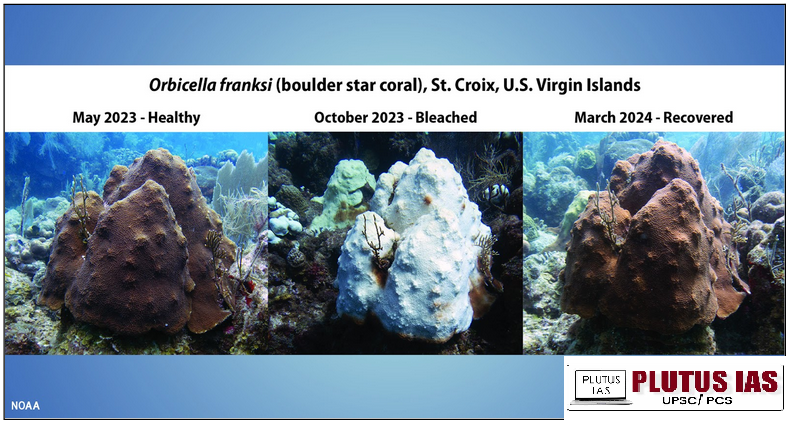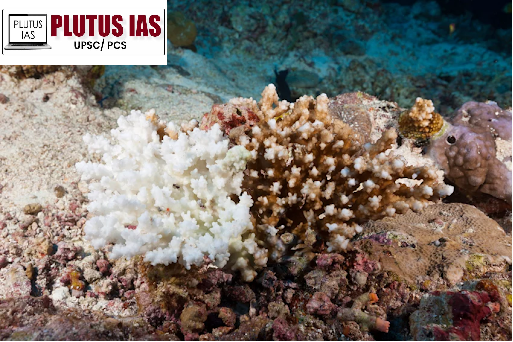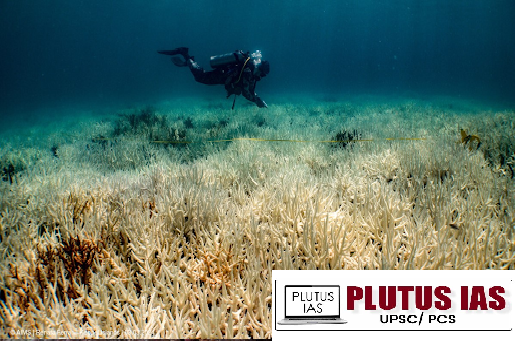05 Dec Fourth Global Coral Bleaching Event
SYLLABUS MAPPING:
GS-3-Environment-Parliament Question: Fourth Global Coral Bleaching Event
FOR PRELIMS:
What are the features of coral, various pre-conditions for coral formation and coral mass bleaching.
FOR MAINS:
What is coral mass bleaching its causes, impact and initiatives taken by international govt. to reduce coral bleaching?
Why in the news?
In India, the Fourth Global Coral Bleaching Event (GCBE4) has affected areas including the Andaman and Nicobar Islands, the Gulf of Mannar, Lakshadweep, and the Gulf of Kachchh.
What are corals?
Corals are marine invertebrates belonging to the phylum Cnidaria, which also includes jellyfish and sea anemones. They are mostly found in warm, shallow ocean waters and play a significant role in marine ecosystems. Corals can be either solitary or colonial, with colonial corals building large reef structures that are crucial to marine life.
Features of coral:
1. Symbiotic Relationship: Corals have a mutualistic relationship with zooxanthellae algae, providing them with nutrients, while algae provide energy through photosynthesis.
2. Coral Polyps: Corals consist of soft-bodied polyps that secrete a calcium carbonate exoskeleton, forming reef structures over time.
3. Coloration: Corals have vibrant colours due to zooxanthellae. Stress can cause coral bleaching, where corals expel the algae and turn white.
4. Feeding: Polyps are carnivorous, capturing plankton with tentacles and also gaining nourishment from photosynthesis by algae.
5. Reproduction: Corals reproduce both sexually and asexually. In asexual reproduction, polyps produce new polyps by budding, growing from the parent colony. In sexual reproduction, corals release eggs and sperm into the water, where fertilization occurs.
6. Growth and Lifespan: Corals grow slowly, some species living over 100 years, while reefs can be thousands of years old.
7. Environmental Sensitivity: Corals are sensitive to temperature, water quality, and acidity. Changes can lead to coral bleaching and other threats from climate change, pollution, and overfishing.

Chronology of Four Major Mass Coral Bleaching Events:
1. 1998: The first major global coral bleaching event, caused by a significant rise in sea temperatures, affected reefs worldwide, including the Great Barrier Reef. This event led to widespread coral mortality.
2. 2010: Another global bleaching event occurred, with extreme temperatures once again stressing coral ecosystems, resulting in severe damage to reefs across the globe.
3. 2014-2017: This extended bleaching event affected more than half of all coral reefs worldwide, including the Great Barrier Reef, where 50% of the reefs perished. In 2017, 75% of the Great Barrier Reef was impacted by bleaching.
4. 2024: The fourth major global bleaching event began, further stressing coral reefs, exacerbated by rising ocean temperatures. If the warming trend continues, it threatens the survival of coral ecosystems worldwide.
Mass Coral Bleaching in India:
1. Widespread Impact: Coral bleaching has been reported in multiple critical marine areas in India, including Lakshadweep, the Gulf of Mannar, Palk Bay of Tamil Nadu, and the Andaman Islands, indicating a widespread environmental crisis.
2. Severe Effects in Lakshadweep: The Lakshadweep archipelago, consisting of 36 islands, has been identified as the most affected region in India. Prolonged marine heatwaves since October 2023 have led to significant coral bleaching, threatening the unique biodiversity of this area.
3. Climate Change Connection: Coral bleaching is primarily driven by rising sea surface temperatures, a direct consequence of climate change. This phenomenon highlights the urgent need to address global warming and its impacts on marine ecosystems.
4. Ecological Consequences: Coral reefs are vital for marine biodiversity, serving as habitats for numerous species. Mass bleaching can lead to the decline of fish populations and other marine organisms, disrupting the entire marine food web.
5. Economic Implications: Many coastal communities in India rely on healthy coral reefs for their livelihoods, particularly in fishing and tourism. The decline of coral health due to bleaching can have severe economic repercussions for these communities.
6. Need for Conservation Efforts: The situation calls for enhanced marine conservation strategies, including the establishment of marine protected areas, sustainable fishing practices, and initiatives to reduce pollution and other anthropogenic pressures.
7. Call for Climate Action: Addressing the root causes of climate change is essential to prevent further coral bleaching events. This includes global efforts to reduce greenhouse gas emissions and promote renewable energy sources.
Causes of Mass Coral Bleaching:
1. Increased Sea Temperatures: The primary cause of mass coral bleaching is elevated sea temperatures, which result from climate change. Corals are highly sensitive to temperature changes, and prolonged exposure to elevated temperatures causes them to expel the symbiotic algae (zooxanthellae) that live within their tissues, leading to bleaching.
2. Storms: Strong storms and cyclones can cause physical damage to coral reefs, increasing their vulnerability to bleaching. The disturbance can also lead to changes in water quality and the amount of sediment suspended in the water, further stressing corals.
3. Disease: Coral diseases, often exacerbated by warmer temperatures, can contribute to bleaching by weakening corals and making them more susceptible to environmental stressors.
4. Sediments: Increased sedimentation from coastal developments, agriculture, or storms can smother corals, block sunlight, and cause them to bleach. Sediment-laden water can also reduce water quality, further stressing coral ecosystems.
5. Changes in Salinity: Fluctuations in salinity, often caused by heavy rainfall, river discharge, or flooding, can stress corals and contribute to bleaching events. For example, freshwater influxes from storms can lower the salinity in coral reef ecosystems, further stressing the corals.
6. El Niño and La Niña Events: During El Niño conditions, warmer sea temperatures and reduced rainfall often lead to mass bleaching on reefs, particularly in the 6. Kimberley region of Western Australia. Conversely, La Niña conditions can cause bleaching events in reefs further south. However, recent years have seen this pattern break down, with mass bleaching occurring in both conditions.
7. Flood Plumes: In 2008 and 2011, coral bleaching in the Great Barrier Reef was exacerbated by an influx of freshwater due to flooding. The flood plumes, which carry excess nutrients and sediments, can alter local water conditions, contributing to coral stress and bleaching.

Impacts of Coral Bleaching:
1. Loss of Biodiversity: Coral reefs are home to a wide variety of marine species, such as sea turtles, fish, and crabs. When coral reefs bleach and die, these species lose their habitats, leading to the potential extinction of vulnerable marine life.
2. Disruption of the Food Chain: Coral reefs support organisms at the base of the ocean food chain. When reefs collapse due to bleaching, it disrupts the entire food web, affecting the survival of many marine species.
3. Decline in Coastal Protection: Coral reefs act as natural barriers against waves and storm surges. Without healthy reefs, coastal communities become more vulnerable to extreme weather events and must rely on costly, less effective, and environmentally damaging man-made alternatives like seawalls.
4. Threat to Fishing Industry: Coral reefs provide spawning grounds for fish and crustaceans. Bleached reefs hinder these processes, reducing fish populations and threatening the livelihoods of those who depend on fishing for income and food security.
5. Impact on Reef Tourism: Coral reefs attract millions of tourists each year for activities like snorkelling and diving. Coral bleaching diminishes the aesthetic value and biodiversity of reefs, leading to a decline in tourism revenue and threatening jobs within the sector.
6. Economic Consequences: The collapse of coral reefs due to bleaching impacts both local and global economies. Communities dependent on reef-based industries like fishing and tourism face economic losses, which can lead to broader socio-economic challenges.
7. Increased Vulnerability to Climate Change: Coral bleaching exacerbates the impacts of climate change, making coastal communities and ecosystems more susceptible to sea-level rise, extreme weather events, and changes in ocean chemistry, further endangering global marine health.
International Initiatives to Protect Coral Reefs:
1. Global Coral Reef Monitoring Network (GCRMN): A global network of scientists and organizations dedicated to monitoring the status of coral reef ecosystems to track their health and provide early warning systems.
2. The Coral Reef Breakthrough: A partnership involving the International Coral Reef Initiative (ICRI), the Global Fund for Coral Reefs (GFCR), and the High-Level Climate Champions (HLCC), working to implement strategies to protect and restore coral reefs worldwide.
3. Reef Restoration and Adaptation Program (RRAP): A program focused on developing strategies and interventions to help coral reefs, such as the Great Barrier Reef, adapt to the challenges of climate change.
4. The Reef-World Foundation: An NGO dedicated to promoting better environmental practices in the marine tourism industry to reduce the human impact on coral reefs.
5. UN Environment Programme: Supports marine protected areas, promotes waste management in ports, and improves waste disposal facilities to reduce the negative impacts on coral ecosystems.
6. Coral Reef Alliance: Focuses on advancing coral conservation science and influencing marine ecosystem management to protect coral reefs globally.
Way Forward to Reduce Coral Bleaching:
1. Avoid Water Pollution: Prevent harmful chemicals from entering water bodies, including household waste, plastics, and industrial chemicals, to preserve coral ecosystems.
2. Minimize Use of Harmful Chemicals: Reduce the use of fertilizers, insecticides, pesticides, and herbicides, as they can contribute to nutrient pollution, which harms coral reefs.
3. Treat Industrial Waste: Properly treat harmful industrial waste before disposing of it into oceans to prevent coral reef degradation.
4. Conserve Water: Efficient water usage helps reduce runoff and excess nutrient flows into oceans, which can lead to coral bleaching.
5. Sustainable Seafood Consumption: Choose sustainably sourced seafood to support marine ecosystems, including coral reefs.
6. Volunteer for Cleanup Efforts: Participate in or organize local efforts to remove trash from beaches and marine environments, reducing threats to coral reefs.
7. Reduce Stormwater and Fertilizer Runoff: Support initiatives that reduce runoff, which carries pollutants and excess nutrients into the ocean, causing coral degradation.
8. Implement Biorock Technology: Use Biorock technology, which involves creating artificial reef structures using electric currents to stimulate coral growth and recovery. This method has been proven to enhance coral resilience to bleaching and improve the survival rates of young corals.

Conclusion
The ongoing Fourth Global Coral Bleaching Event highlights the urgent need to address climate change, as rising sea temperatures threaten coral reefs in India and globally. Coral bleaching disrupts marine ecosystems, harms biodiversity, and impacts local economies. Immediate conservation efforts, including reducing pollution, protecting marine areas, and combating climate change, are essential to preserve coral reefs. International initiatives focused on monitoring, restoration, and sustainable practices offer hope, but global action is critical to prevent further degradation and ensure the survival of these vital ecosystems.
Download Plutus IAS Current Affairs Eng Med 5th Dec 2024
Prelims Question:
Q. Consider the following statements regarding coral reefs:
1. Corals are marine invertebrates belonging to the phylum Cnidaria.
2. Coral reefs are primarily formed by solitary corals.
3. Coral bleaching occurs when corals expel symbiotic algae due to elevated sea temperatures.
4. Coral reefs do not play a significant role in marine ecosystems.
Which of the above statements is/are correct?
A. 1 and 3 only
B. 1, 2, and 3 only
C. 1 and 3 only
D. 1, 3, and 4 only
Answer: A
Mains Question:
Q. “Mass coral bleaching events, driven by rising sea temperatures and climate change, are severely impacting marine ecosystems worldwide. Discuss the causes, effects, and measures to mitigate coral bleaching.
(250 words, 15 marks)




No Comments